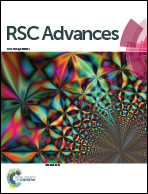Synthesis and degradable properties of cycloaliphatic epoxy resin from renewable biomass-based furfural†
Abstract
Biomass-based cycloaliphatic epoxy resin (Epoxide-A) with two epoxycyclohexyls linked with an acetal group was synthesized by utilizing furfural as a major raw material through a facile two-step preparation: synthesis of a diene precursor and subsequent epoxidation. The chemical structures of Epoxide-A and its precursor were confirmed by FTIR and 1H NMR spectroscopy. Compared with the commercial cycloaliphatic epoxy resin ERL-4221, the cured Epoxide-A exhibits a similar glass transition temperature and thermal decomposition temperature but significantly higher mechanical modulus, shearing strength and lower coefficient of thermal expansion. More importantly, it is found that the cured Epoxide-A can readily degrade in an acidic aqueous solution due to the labile acetal linkages distributed within the cross-linked network, and the degradation apparently accelerates with the increase of the solution acidity. This peculiar degradation property provides a feasible after-treatment application for the products fabricated with epoxy resin, e.g., in the recovery of precious metal and carbon fiber from electronic waste and carbon fiber-reinforcing composite materials.


 Please wait while we load your content...
Please wait while we load your content...